原标题:转录组学分析揭示丁酸甘油酯对肉用仔鸡脂质分解代谢基因表达的调控研究
Transcriptome Analysis Reveals Regulation of Gene Expression for Lipid Catabolism in Young Broilers by Butyrate Glycerides
作者:Fugui Yin1 , Hai Yu1 , Dion Lepp1 , Xuejiang Shi2 , Xiaojian Yang1 , Jielun Hu3 , Steve Leeson4, Chengbo Yang5 , Shaoping Nie3 , Yongqing Hou6 , Joshua Gong1*
1 Guelph Research and Development Centre, Agriculture and Agri-Food Canada, Guelph, Ontario, Canada,
2 Next Generation Sequencing Platforms, Clinical Genomics Centre, the UHN/MSH Gene Profiling Facility, Toronto, Ontario, Canada,
3 State Key Laboratory of Food Science and Technology, Nanchang University,
Nanchang, Jiangxi, China,
4 Department of Animal and Poultry Science, University of Guelph, Guelph,
Ontario, Canada,
5 Department of Animal Science, University of Manitoba, Winnipeg, Manitoba, Canada,
6 Hubei Key Laboratory of Animal Nutrition and Feed Science, Wuhan Polytechnic University, Wuhan, Hubei, China
来源:PLOS ONE | DOI:10.1371/journal.pone.0160751 August 10, 2016
翻译:肠动力研究院
【摘要】
背景与目的:丁酸已被证明可有效调节动物的能量消耗和脂质代谢,但其中潜在的分子机制仍有待进一步研究。本文旨在通过两个试验来探究丁酸(丁酸甘油酯的形式,BG)影响肉鸡空肠和肝脏中脂质代谢基因表达水平的分子机制。方法/主要结果:试验一:240羽1日龄Ross 308肉用仔鸡根据体重均匀的分成两组,对照组(BD):饲喂基础日粮;丁酸甘油酯组(BG):喂食基础日粮+3000ppm丁酸甘油酯的混合物和/或单丁酸甘油酯,每组30羽,每组4个重复,试验为期40天,试验结束后分析这批肉鸡的平均日增重,平均日采食量以及饲料转化率。试验二:40羽1日龄肉用仔鸡根据体重平均分成两组,对照组(BD):饲喂基础日粮;丁酸甘油酯组(BG):喂食基础日粮+3000ppm丁酸甘油酯的混合物和/或单丁酸甘油酯,每组20羽,试验为期21天,试验结束后比较处理组之间肉鸡的生长性能、腹脂沉积,血脂组成及血清和组织中参与脂质代谢的关键酶的浓度。RNA-seq用于鉴定差异表达的基因(DEG)和处理组特异性表达的基因(TSEG)。使用IPA和DAVID-BR 6.7这两种软件来检测DEG和TSEG的功能性聚类以及与脂质代谢相关的信号传导通路。随后进行定量PCR(q-PCR)测定以进一步检查由DAVID-BR鉴定的过氧化物酶体增殖物激活受体(PPAR)信号传导途径中的基因表达。结果显示,日粮添加BG可干预并显著降低肉鸡的腹脂率(腹脂重/最终体重)。BG组肉鸡的脂肪沉积减少与与血清脂肪组成及腹部脂肪,空肠和肝脏中脂质代谢相关酶的水平一致。RNA-seq分析表明膳食BG分别在空肠和肝脏中干预诱导了79和205个特征性DEGs。此外,在BG组肉鸡的肝脏和空肠中检测到255和165个TSEG,而在BD组肉鸡的肝脏和空肠其中则观察到162和211个TSEGs基因。用IPA和DAVID-BR进行的生物信息学分析进一步揭示了生物过程中DEGs和TSEG的显著富集,其目的是为了减少空肠中脂质的合成,储存,运输和分泌,而肝脏中这部分基因的增加则主要用于增强机体对摄入的脂类和脂肪酸的氧化作用。特别地,日粮添加BG可通过显著诱导THRSP和EGR-1这两种转录调节因子以及参与PPAR-α信号传导途径的几个DEG来干预脂质分解代谢。
结论:研究结果表明,BG可通过调节相关基因的表达来减少体内脂肪沉积,而这个过程可能与相关物质的合成、储存、运输和分泌的减少以及脂质和脂肪酸的氧化水平相应提高的生理活动有关。
以下是相关图表
表1:丁酸甘油酯对肉鸡生长性能,脂肪沉积和小肠发育的影响。
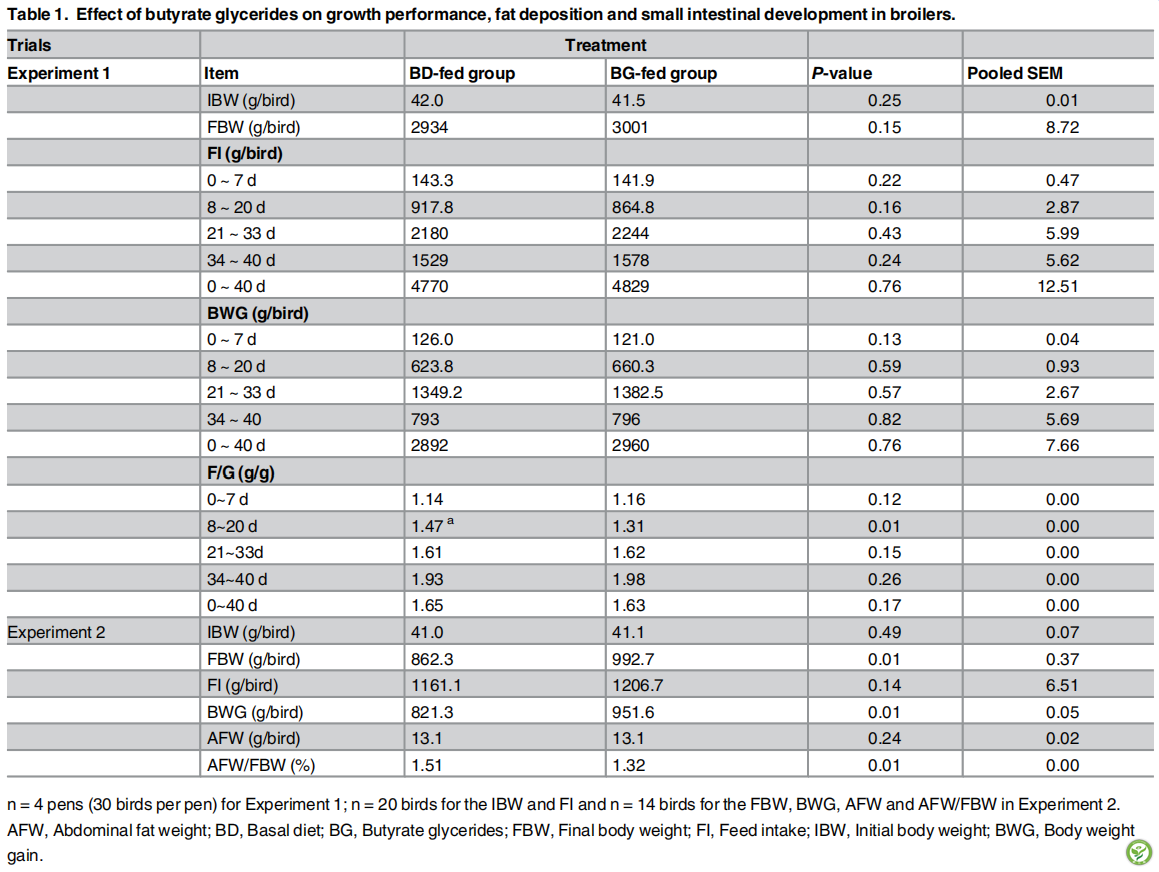
表2:丁酸甘油酯对肉鸡组织中血清代谢物浓度以及组织中总蛋白和相应关键酶的影响。
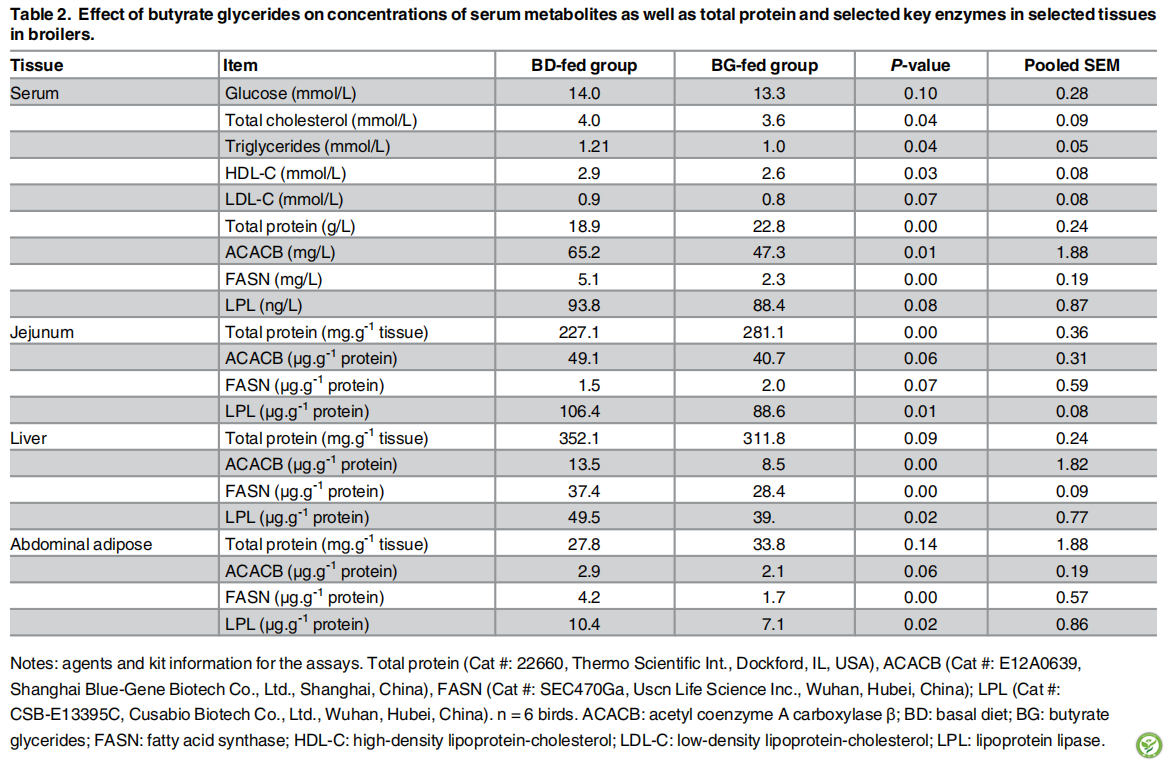
表3:RNA测序谱

表4:丁酸甘油酯处理的肉鸡中时富含DEGs的生理活性

表5:处理组中含有的生理功能对应在肉鸡中的特异性表达基因
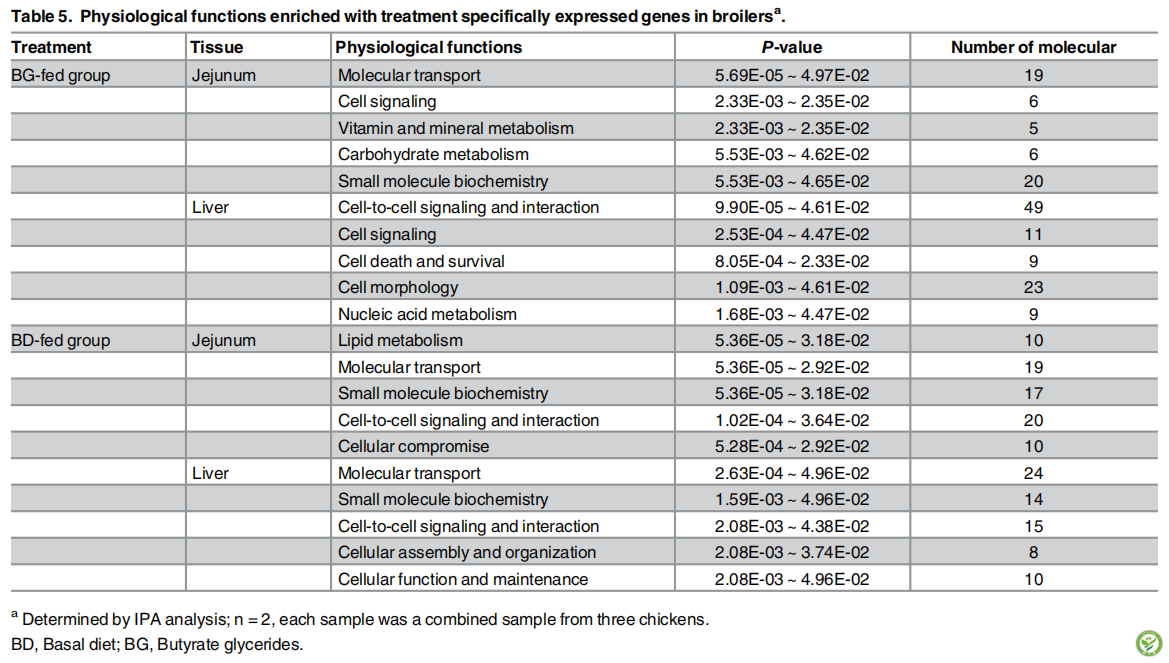
表6:丁酸甘油酯处理的肉鸡对应相关的KEGG通路。

表7:丁酸甘油酯处理的肉鸡下对PPAR-α信号通路所选定的基因进行RNA-seq和qPCR分析
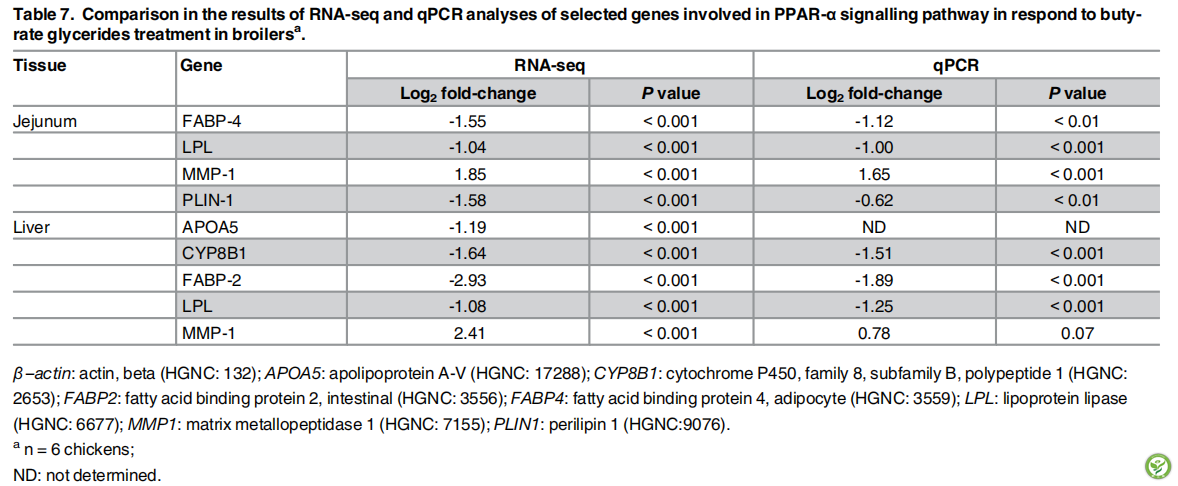
图1:丁酸甘油酯对肉鸡空肠PPAR信号通路下游基因的影响。带有虚线外线和全内线的文本框中的基因被下调,而带有完整外线和虚线内部的文本框中的基因与对照组相比上调。所有的基因均表达显示出显著的差异(P≤0.05)以及Log2fold change的绝对值要≥1。该图是基于DAVID-BR分析的结果生成的。
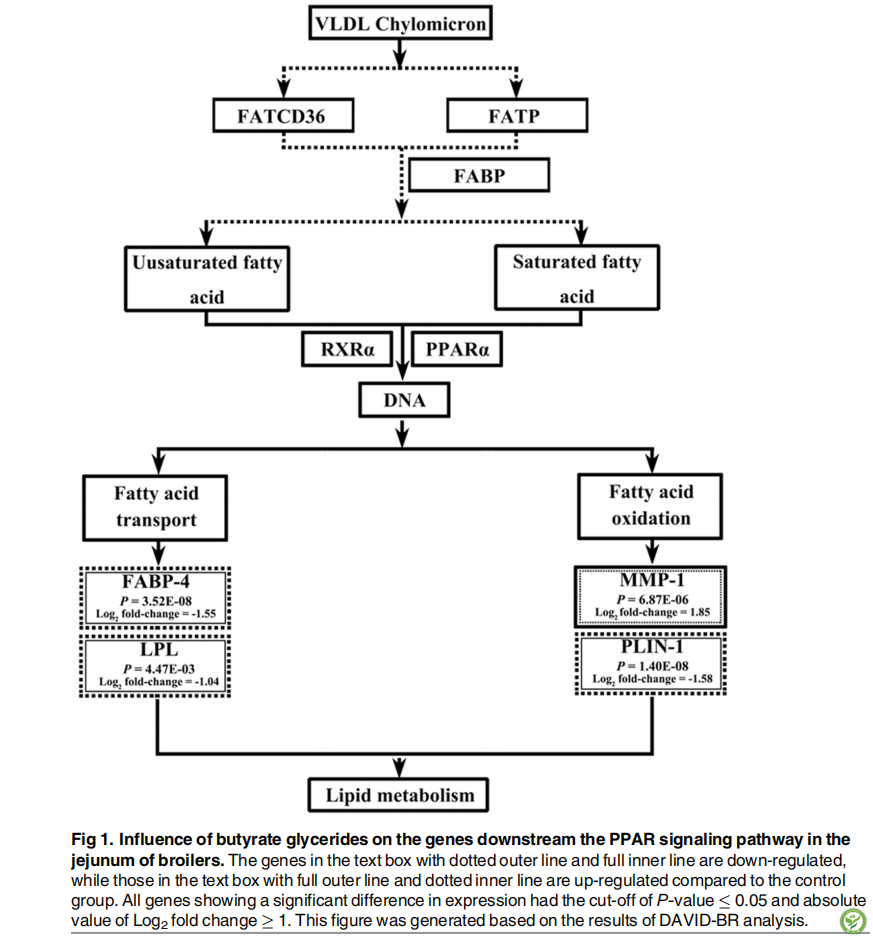
图2:丁酸甘油酯对肉鸡肝脏PPAR信号通路下游基因的影响。带有虚线外线和全内线的文本框中的基因被下调,而带有完整外线和虚线内部的文本框中的基因与对照组相比上调。所有的基因均表达显示出显著的差异(P≤0.05)以及Log2fold change的绝对值要≥1。该图是基于DAVID-BR分析的结果生成的。
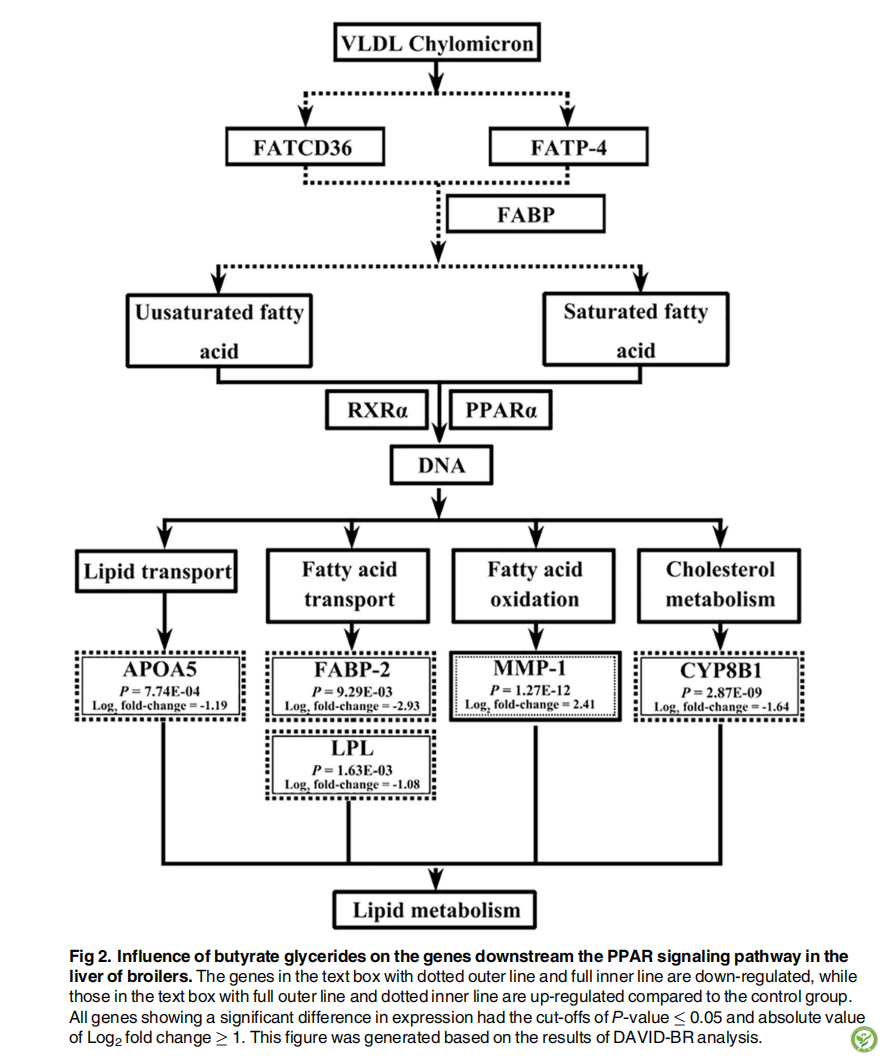
结论
总之,本研究表明,膳食BG干预显著降低了肉用仔鸡的体脂沉积。其中,BG组肉鸡的脂肪沉积减少与血清,腹部脂肪,空肠和肝脏中脂质代谢所涉及的关键酶的水平一致。BG处理可调节相关基因的表达,这个过程在空肠中主要涉及与脂质的合成,储存,运输和分泌减少的生理活动,而在肝脏中主要涉及增强机体对摄入的脂质和脂肪酸的氧化水平。这些研究结果为设计调节摄入的能量分布和改善动物/人类营养和健康的新策略提供了有用的参考。
Abstract
Background & Aims:Butyrate has been shown to potently regulate energy expenditure and lipid metabolism in animals, yet the underlying mechanisms remain to be fully understood. The aim of this study was to investigate the molecular mechanisms of butyrate (in the form of butyrate glycerides, BG)-induced lipid metabolism at the level of gene expression in the jejunum and liver of broilers.Methodology/Principal Findings:Two animal experiments were included in this study. In Experiment 1, two hundred and forty male broiler chickens were equally allocated into two groups: 1) basal diet (BD), 2) BG diets (BD + BG). Growth performance was compared between treatments for the 41-day trial. In Experiment 2, forty male broiler chickens were equally allocated into two groups. The general experimental design, group and management were the same as described in Experiment 1 except for reduced bird numbers and 21-day duration of the trial. Growth performance, abdominal fat deposition, serum lipid profiles as well as serum and tissue concentrations of key enzymes involved in lipid metabolism were compared between treatments. RNA-seq was employed to identify both differentially expressed genes (DEGs) and treatment specifically expressed genes (TSEGs). Functional clustering of DEGs and TSEGs and signaling pathways associated with lipid metabolism were identified using Ingenuity Pathways Analysis (IPA) and DAVID Bioinformatics Resources 6.7 (DAVID-BR). Quantitative PCR (qPCR) assays were subsequently conducted to further examine the expression of genes in the peroxisome proliferator-activated receptors (PPAR) signaling pathway identified by DAVID-BR. Dietary BG intervention significantly reduced abdominalfat ratio (abdominal fat weight/final body weight) in broilers. The decreased fat deposition in
BG-fed chickens was in accordance with serum lipid profiles as well as the level of lipid metabolism-related enzymes in the serum, abdominal adipose, jejunum and liver. RNA-seq analysis indicated that dietary BG intervention induced 79 and 205 characterized DEGs in the jejunum and liver, respectively. In addition, 255 and 165 TSEGs were detected in the liver and jejunum of BG-fed group, while 162 and 211 TSEGs genes were observed in the liver and jejunum of BD-fed birds, respectively. Bioinformatic analysis with both IPA and DAVID-BR further revealed a significant enrichment of DEGs and TSEGs in the biological processes for reducing the synthesis, storage, transportation and secretion of lipids in the jejunum, while those in the liver were for enhancing the oxidation of ingested lipids and fatty acids. In particular, transcriptional regulators of THRSP and EGR-1 as well as several DEGs involved in the PPAR-αsignaling pathway were significantly induced by dietary BG intervention for lipid catabolism.Conclusions:Our results demonstrate that BG reduces body fat deposition via regulation of gene expression, which is involved in the biological events relating to the reduction of synthesis, storage, transportation and secretion, and improvement of oxidation of lipids and fatty acids.
Conclusions
In summary, the present study has shown that dietary BG intervention significantly reduced body fat deposition in young broiler chickens. The decreased fat deposition in BG-fed chickens was in accordance with the level of selected key enzymes involved in lipid metabolism in the serum, abdominal adipose, jejunum and liver. The expression of genes altered by BG treatment, in the jejunum was mainly involved in the biological events for reducing the synthesis, storage, transportation and secretion of lipids, while that in the liver was mostly involved in enhancing the oxidation of ingested lipids and fatty acids. These findings provide a useful reference for the design of new strategies to regulate the ingested energy distribution and to improve animal/ human nutrition and health.
如您需原文,请联系本文作者和出版方,或请垂询肠动力研究院。本网站发布的所有资料将尽最大可能注明出处、作者及日期,如无意中侵犯了您的知识产权,请来信及时告知,我们将立即予以删除。
All information released by the WeChat Official Account will do its best to indicate the source, author and date. If we inadvertently infringe on your intellectual property, please inform us in time and we will delete it immediately.








